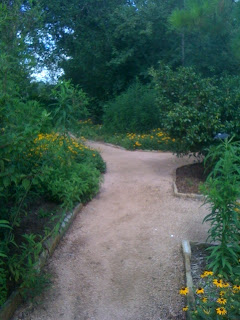my oh my....Passiflora incarnata
There's a wise old garden saying that goes, “a weed is a plant out-of-place,” which means that 1) all “weeds” are not necessarily weeds, and 2) sometimes a “weed” coming up in the “right place” is a good thing...perhaps even better than one (or more!) of the plants that the gardener might have originally chosen for that place.
Personally, I can't even begin to count the number of plants that I've planted and lost in our gardens, and worse, client's gardens – hundreds, if not thousands over the past 35 years. By the same token, I'd also have a difficult time remembering all of the “accidental” plants – let's not call them weeds – that have come up (“volunteered”) in gardens which ended up making a better showing than the plants that I had originally intended for said spots.
passion vine festoons our 7' X 8' swamp rose
A perfect example occurred this past summer at our place. Out of nowhere, a native passion vine (Passiflora incarnata) took root under our swamp rose. Lydia and I both noticed it at the same time. We both received it with great delight, since both of us had unsuccessfully tried on several occasions over the years to get it started at our place. I mean, what's up with that? Here we are, two professional gardeners, and neither of us can make a local weed happy at our place? Yes kids, if you have not found out already, gardening is one of the most humbling of human endeavors. . . over the years we've found out that humble turns out to be a good thing, though. . .
note the tri-lobe leaves (esp. lower left)...learn the leaf
and you can identify the plant when it's not in bloom...
Anyway, up comes the passion vine. Plentiful rains have it growing at the speed of light – or at least water. . . It winds up and around and around the swamp rose. It jumps on the daylily row next to the ditch, and then onto the wild hibiscus in the ditch. Where she stops, nobody knows. We're loving it. . .
Passion vine (aka passion flower) is a member of the plant family Passifloraceae, a tropical family containing a dozen genera and over 600 species – about 500 of which are passion vines (genus Passiflora). Here in Louisiana, two species of Passiflora natively occur. Passiflora lutea, called yellow passionflower, is a small, delicate, shade-loving woodland vine; whereas Passiflora incarnata, called purple passionflower, is a large, husky, tough, sun-loving vine found in agricultural fields and other disturbed areas. Yep, many if not most farmers consider it a bad weed. What a weed, non?!!???
P. incarnata fruit
Another common name for P. incarnata is “maypop,” probably in reference to the fruit. As is the case with most species of passion vine, the fruits of P. incarnata are quite tasty, offering a sweet/tart flavor mix.
inside, each seed is encapsulated with its very own
envelope of juicy pulp...
Historically, French-speaking Louisianians called the fruit, grenade (pron. Grah-NOD), and made a refreshing lemonade-like drink from it. In his Edible Plants of the Gulf South (2005, Allen's Native Ventures, 337.328.2252), Charles Allen proclaims all parts – leaves, flowers, and fruits – of Passiflora incarnata to be edible.
Gulf Fritillary Butterfly
(nectaring off of red porterweed)
Passiflora incarnata is a primary host-plant for the larvae of both Gulf Fritillary and Zebra Longwing butterflies.




















